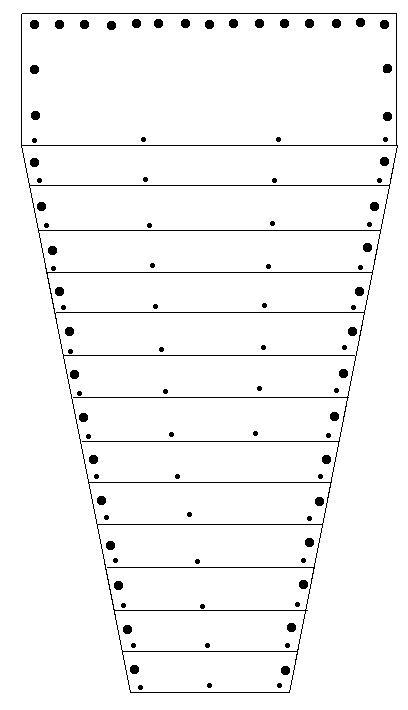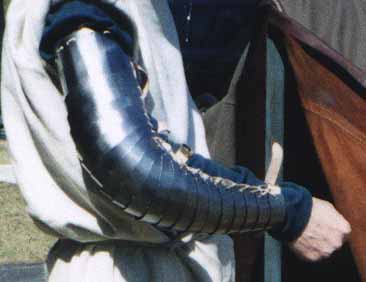
|
At left is a drawing of
Robinson's
reconstruction of the Newstead piece. It was made of rather thin
brass.
The top plate is about 10" by 3-1/2" with the top edge turned
down.
The 13 narrow plates are about 1-1/8" wide and taper in length down to
about 4-1/4" at the bottom. The plates are shown edge-to-edge,
not
overlapped as they would be when assembled. The smaller dots are
rivet holes c. 1/8" in diameter, flat-head rivets being used to secure
the internal leather strips (the rivets were put in place from the
inside,
first through the leather and then through the metal, being peened flat
on the outside as on a lorica). Note that there are 4 leathers,
one
of which extends only halfway down. Also note that the plates
overlap
upwards, not downwards as on a lorica.
The larger dots are holes (c.
3/16" diameter) which are apparently for lacing the assembled plates to
a leather or fabric lining. This lining would then be strapped or
laced to the arm. If all of the laceholes are used to lace the
manica
directly to the arm, there will not be enough flexibility at the
elbow.
It has been suggested that Robinson's reconstruction is incomplete and
that some sort of larger elbow plate is necessary, but none are shown
on
the Adamklissi monument, nor on depictions of gladiator
armguards.
Robinson's reconstruction may also be too short, since he believed it
was
a thigh guard. The placement of the internal leathers is curious,
since they will cover the laceholes, though that may not have been the
case with some of the Carnuntum fragments.
Dr. Bishop also tells of
a recent
find of a complete iron manica from Romania, as yet unpublished.
It has about 27 plates including a wider top plate like the Newstead
example,
and no distinctive elbow couter, and it wraps more than halfway around
the arm. Three complete or partial manicae were also
unearthed
at Carlisle early in 2001, but they have yet to be conserved or
published.
 |
Click on the
thumbnail at left
to see a larger image of my reconstructed manica (15 K). It has
20
plates, the narrow ones 1-1/8" wide and the large one 3-1/2"
wide.
(The metal is not blued, it's just reflecting the sky!) There are
three internal leathers, not four as in Robinson's version. There
are 4 straps and buckles (sorry, one set has gotten folded under in
this
photo), though the second set from the bottom needs to be moved down a
little to allow the best flexibility. |
 |
This thumbnail
leads to a photo
of the inside. It is lined with calfskin, and the straps are sewn
to the lining. Leather tabs have been added to keep the buckles
from
digging into the skin. The lining is held in by a leather thong
that
runs in a spiral through all the plate holes on each side.
Flexing
makes a scissors-like action which tends to cut the thongs at the
elbow,
hmmm... |
(Photos courtesy of George Metz)
|


